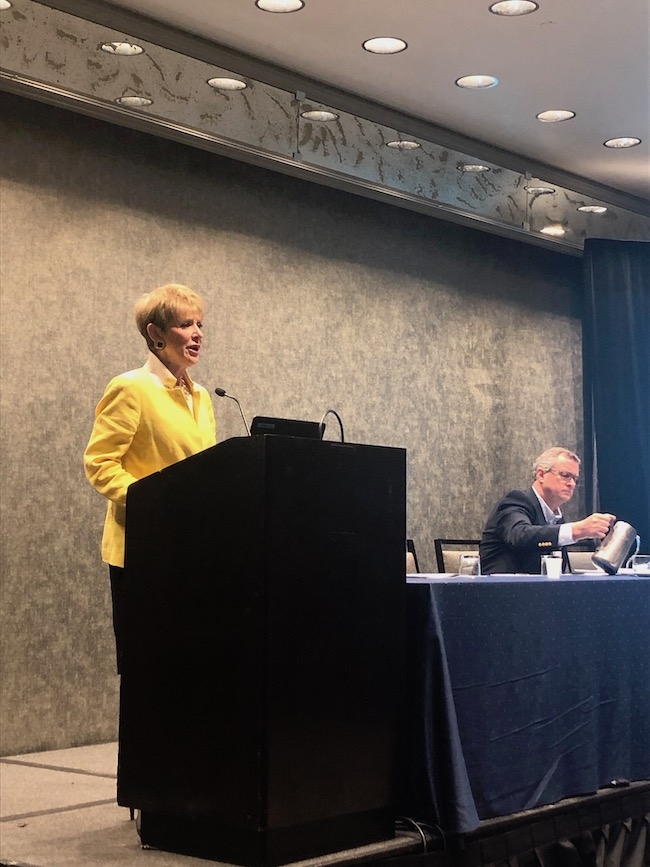
Features
Recirc
RAStech 2019 debuts as industry predicts promising future for RAS
WASHINGTON, D.C. – Recirculating aquaculture systems (RAS) and developments in biotechnology will help address the world's increasing food supply challenges, said Sylvia Wulf, president and CEO of Aquabounty in her keynote address at RAStech 2019.
May 15, 2019 By Mari-Len De Guzman
 Aquabounty CEO and president Sylvia Wulf
Aquabounty CEO and president Sylvia Wulf “We have to be able to steward the environment in a different way moving forward,” Wulf told close to 275 attendees at the conference held in Washington, D.C., this week. Sustainable food production through RAS will enable the farming of fish wherever the consumers are, Wulf said.
Aquabounty’s AquAdvantage salmon is the first genetically engineered seafood that passed regulatory approvals from both Canada and the U.S. for commercial production. They have been developed to be raised in RAS environments, alleviating concerns about fish escapes that can impact wild fish populations, Wulf said.
“In 30 years, we will have 2 billion more people to feed,” Wulf said in her keynote. “I believe a hundred per cent of seafood growth is going to come from aquaculture, and RAS is going to become increasingly important.”
“Our (AquAdvantage) fish was specifically designed to operate in a (RAS) environment. We continue to optimize those growing conditions so that we are recirculating close to 99 per cent of the water,” the AquaBounty chief executive added.
Aquaculture professionals from 21 countries gathered in Washington, DC, this week for the RAStech 2019 tradeshow and conference. The conference featured two days of RAS-focused education sessions with over 70 speakers from around the world with presentations on shrimp farming in RAS, energy optimization, engineering innovations, feeds management as well as health and disease management in RAS.
Related: RAStech 2019 Photo Gallery
The team from The Conservation Fund’s Freshwater Institute presented some of its latest research on RAS, including: results from a preliminary investigation on integrating membrane biological reactors within RAS; effects of photoperiods in growth, health and maturation of Atlantic salmon in RAS; the economies of scale; fillet and product quality, among other things.
In her keynote address, Wulf enumerated some of the benefits of RAS production in sustainable aquaculture, including the ability to put RAS facilities “close to consumption” limiting the environmental impact of food production, and the biosecurity of RAS which reduces the risk for diseases and eliminates the need for antibiotics.
“There is such a great environmental story that goes along with RAS,” Wulf said. “As we think about the sustainability story, consumers are more and more aware and asking questions about the sustainability of how their food is made.”
Alejandro Roxas, AquaBounty’s chief operating officer, also delivered a keynote presentation highlighting the importance of people in the success of RAS operations.
“When we think about RAS, we have the image that we are in a box,” Rojas said. However, he added, RAS operations involve a diverse array of expertise and skills to ensure optimal performance – from water quality monitoring and energy efficiency to vendor and supplier management, construction and transportation.
Skills development, knowledge-sharing
Rojas stressed the need for aquaculture organizations to engage the universities and colleges in the communities they operate to ensure the educational institutions are producing the quality of people with the necessary skills to operate efficiently from multiple fronts in RAS environments.
Attendees at RAStech generally agree there is thirst for knowledge and information sharing when it comes to RAS. Still in its early stages, but quickly gaining momentum, land-based aquaculture is touted as a significant development in sustainable seafood production.
For Australian Scott Parkinson, CEO of Ornatas in Tasmania, RAStech has been a “fantastic” opportunity to connect and engage with like-minded professionals in the RAS industry. Ornatas is developing the world’s first-ever commercial hatchery for tropical rock lobsters.
Parkinson and Greg Smith, University of Tasmania associate professor and the director of the ARC Research Hub for Commercial Development of Rock Lobster Systems, were among the international attendees at this year’s RAStech conference.
Future growth
Attendees also expressed optimism about the future of RAS.
Eric Pedersen, president and CEO of Ideal Fish, believes RAS is going to be an “explosive” area of growth. Ideal Fish grows European seabass (Dicentrarchus Labrax) to harvest size in a 63,000-sq.ft. state-of-the-art RAS facility in Waterbury, Connecticut in the U.S.
“I think (RAS is) going to be an explosive area of growth in aquaculture, particularly in the United States where aquaculture is just beginning to get a toehold in the seafood production chain,” Pedersen told Hatchery International.
“Having conferences like this that brings professionals from academia, from industry, from finance together to support this industry is going to be an increasingly crucial part of this development.”
For Robin Muzzerall, vice-president for aquaculture at Icy Waters Arctic Charr in Whitehorse, Yukon Territory in Canada, the conference is an opportunity to learn about RAS technologies.
“We currently don’t have RAS where I am so part of my reason for coming here is to educate myself to see what is out there now compared to about five years ago, and start making good choices when we speak to designers,” Muzzerall told Hatchery International.
RAStech 2020
Making plans to attend the next RAStech? Save the date now for November 16-17, 2020 for RAStech 2020 to be held in South Carolina, U.S.A. Check www.ras-tec.com regularly for more details.
Print this page





